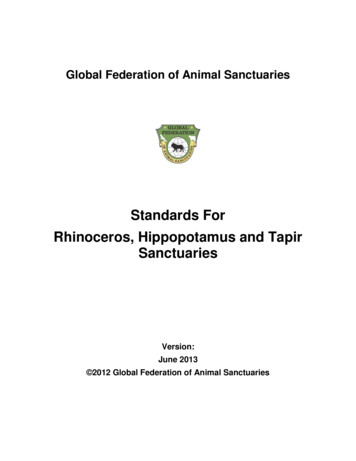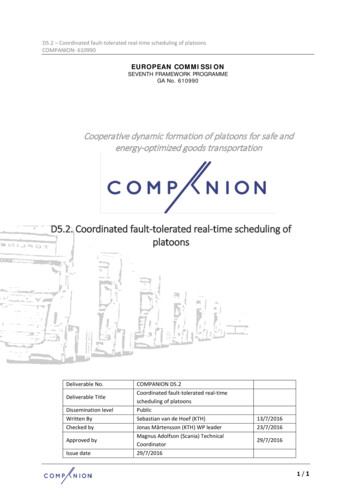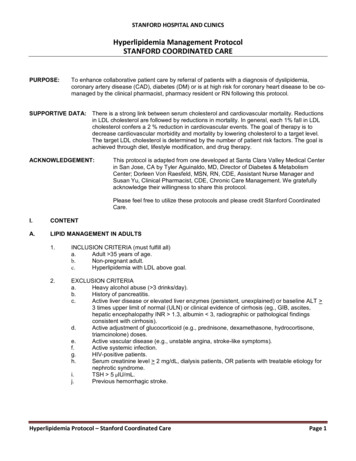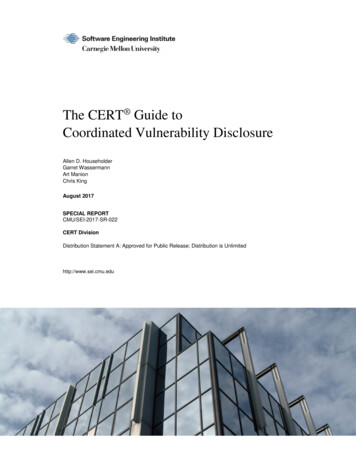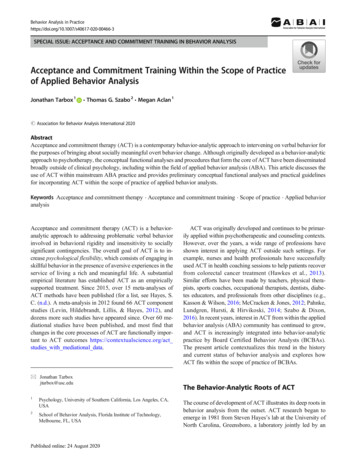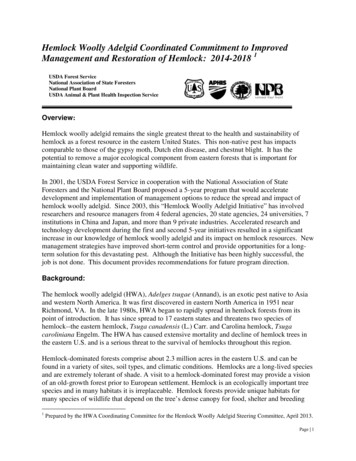
Transcription
Hemlock Woolly Adelgid Coordinated Commitment to ImprovedManagement and Restoration of Hemlock: 2014-2018 1USDA Forest ServiceNational Association of State ForestersNational Plant BoardUSDA Animal & Plant Health Inspection ServiceOverview:Hemlock woolly adelgid remains the single greatest threat to the health and sustainability ofhemlock as a forest resource in the eastern United States. This non-native pest has impactscomparable to those of the gypsy moth, Dutch elm disease, and chestnut blight. It has thepotential to remove a major ecological component from eastern forests that is important formaintaining clean water and supporting wildlife.In 2001, the USDA Forest Service in cooperation with the National Association of StateForesters and the National Plant Board proposed a 5-year program that would acceleratedevelopment and implementation of management options to reduce the spread and impact ofhemlock woolly adelgid. Since 2003, this “Hemlock Woolly Adelgid Initiative” has involvedresearchers and resource managers from 4 federal agencies, 20 state agencies, 24 universities, 7institutions in China and Japan, and more than 9 private industries. Accelerated research andtechnology development during the first and second 5-year initiatives resulted in a significantincrease in our knowledge of hemlock woolly adelgid and its impact on hemlock resources. Newmanagement strategies have improved short-term control and provide opportunities for a longterm solution for this devastating pest. Although the Initiative has been highly successful, thejob is not done. This document provides recommendations for future program direction.Background:The hemlock woolly adelgid (HWA), Adelges tsugae (Annand), is an exotic pest native to Asiaand western North America. It was first discovered in eastern North America in 1951 nearRichmond, VA. In the late 1980s, HWA began to rapidly spread in hemlock forests from itspoint of introduction. It has since spread to 17 eastern states and threatens two species ofhemlock--the eastern hemlock, Tsuga canadensis (L.) Carr. and Carolina hemlock, Tsugacaroliniana Engelm. The HWA has caused extensive mortality and decline of hemlock trees inthe eastern U.S. and is a serious threat to the survival of hemlocks throughout this region.Hemlock-dominated forests comprise about 2.3 million acres in the eastern U.S. and can befound in a variety of sites, soil types, and climatic conditions. Hemlocks are a long-lived speciesand are extremely tolerant of shade. A visit to a hemlock-dominated forest may provide a visionof an old-growth forest prior to European settlement. Hemlock is an ecologically important treespecies and in many habitats it is irreplaceable. Hemlock forests provide unique habitats formany species of wildlife that depend on the tree’s dense canopy for food, shelter and breeding1Prepared by the HWA Coordinating Committee for the Hemlock Woolly Adelgid Steering Committee, April 2013.Page 1
sites. Hemlock is commonly associated with riparian areas and has been shown to play animportant role in buffering stream water temperatures and preventing erosion on steep banks. Itis a preferred nesting and denning habitat for a significant number of wildlife species. As aforest resource, hemlock’s value to fish and wildlife and its contribution to the ecology ofimportant riparian areas likely exceed its timber value. Aesthetically, hemlocks are highly valuedin recreational areas and urban landscapes. In the urban environment, hemlock is one of themost common species planted by homeowners.Key Issues:Continued Spread. HWA currently infests nearly one half of the native range of hemlock in theEast. It can be found from southeastern Maine to northeastern Georgia and as far west as easternTennessee (Figure 1). The HWA continues to spread at an average rate of 12.5 km per year.HWA has also been found in isolated locations in Vermont, Ohio, and Michigan as the result ofinfested nursery stock being transported from the generally infested area. Forestry andagriculture officials in those three states have undertaken eradication efforts and Maine, NewHampshire, Vermont, Ohio, Wisconsin and Michigan have implemented quarantines. Reducingthe rate of artificial spread and overall impact of HWA have become the primary managementgoals.Figure 1. County-Level Distribution of Hemlock Woolly AdelgidResource Impacts. Areas of extensive tree mortality and decline are found throughout theinfested region, but the impacts have been most severe in Virginia, Pennsylvania, West Virginia,New Jersey, Connecticut and, more recently, North Carolina and Tennessee. The rate of spreadand magnitude of impact have thus far been lower in the insect’s more northerly range; this isPage 2
likely the result of severe winter temperatures that periodically cause a reduction in adelgidnumbers. Conversely, HWA expansion in the southern range has been much more rapid and theimpacts to the southern hemlock resource are expected to be devastating. Harvesting of hemlockis proceeding at a rapid pace in infested states as landowners attempt to salvage value fromthreatened trees. In general, the impacts of HWA on hemlock forests and ecosystems areexpected to intensify throughout the range of eastern hemlock. Without intervention, hemlock isat risk of becoming an inconsequential component of forest ecosystems and urban landscapesthroughout its range.Key accomplishments over the last 10 years: The predatory beetle Laricobius nigrinus (native to the Pacific Northwest) has beensuccessfully established in 13 states and can now be collected in sufficient numbers inseveral areas for redistribution to other HWA-infested forests in the East. More than 2.5 million Sasajiscymnus tsugae predatory beetles (native to Japan) havebeen reared and released throughout the East and this species is now established in manyareas. Several additional natural enemies have been identified and are progressing towardrelease against HWA. They include 2 species of Scymnus lady beetles (one from Chinaand one from the Pacific Northwest), Leucopis flies from the Pacific Northwest, and amore voracious Laricobius species from Japan. A web-based HWA predator database was created to track all predator release locationsand monitor establishment results. An interactive web-based HWA bibliography database was created and linked to theHWA website to provide rapid access to all published HWA and hemlock relatedliterature citations and abstracts. Prepared and published a comprehensive book on the HWA biological control programtitled “Implementation and Status of Biological Control of the Hemlock WoollyAdelgid”. Two systemic insecticides (imidacloprid and dinotefuran) are now registered andavailable for use in the forest environment. These insecticides are currently used toprotect high-value hemlock forests throughout the East. Resistant hemlock genotypes, either of putative susceptible species identified fromdevastated landscapes or through breeding with resistant species, are under evaluationand development. Molecular genetics technology has been used to pinpoint the origin of HWA and identifyseveral distinct populations of HWA worldwide. The science of molecular genetics hasbeen invaluable for the biological control program by providing an efficient means toidentify morphologically similar species of Laricobius and Leucopis predators and as atool to recognize, monitor and manage the hybridization between closely-relatedLaricobius species. Improved assessments of impacts have been developed through classical economics aswell as remote sensing. Several survey methods for assessing HWA infestations were developed which can betailored to various objectives.Page 3
Information transfer has greatly improved access to available information: a websitededicated to HWA (http://na.fs.fed.us/fhp/hwa/) is in place that provides both the publicand researchers with up-to-date information, four symposia were held that provided aforum for managers and researchers alike to find out what is being done over the fullrange of topics, and proceedings from the symposia that serve as quick references werepublished. State and federal resource managers can now actively manage their hemlock resourcesand protect high-value stands from HWA.Recommendations for Future Program Direction:The knowledge base needed to develop and implement an effective HWA management programwas increased significantly during the 2003-2013 period of this initiative. Progress in managingHWA has been made, but additional investments in research and technology development areneeded to advance long-term management strategies, particularly in the areas of biologicalcontrol, host resistance and insecticidal management.By 2016, we expect a much reduced need for research and methods development in the area ofclassical biological control as we will have completed the necessary evaluations and initiated theestablishment of all of the known summer and winter HWA predators believed necessary forlong-term management. Efforts beyond this timeframe will be more operational in nature andconsist primarily of rearing, field collecting, augmentative and classical release and evaluation ofexisting natural enemies as HWA continues to expand its range. Further work in the areas ofhost resistance and silvicultural management will likely need to continue into the next decade asthese areas of research and development progress. Evaluation of new insecticides and/orapplication methods as they become available should continue as newer classes of insecticidesand application methods suitable for the forest environment become available. We anticipate theexisting methods development work related to the aerial application of the fungal pathogenLecanicillium muscarium will be minimal as we expect to be fully operational by 2016.Continued research in the areas of HWA biology and ecology should continue, particularly in theinvestigations of HWA symbiotes.Recommendations for 2014-2018 activities are summarized in Appendix A and include thefollowing:Biological Control: Although two predatory beetles have been established for biological controlof HWA, these are spreading slowly. Additional species and better methods are needed toaccelerate spread and to increase populations to levels that can suppress and maintain HWAbelow damaging levels. Three additional beetles have been approved for release and bettermethods of mass producing them need to be developed. Several candidates in quarantine in thewestern U. S. need further evaluation and development of rearing methodology. Prioritiesinclude:1. Continue quarantine screening of newly discovered predators and begin fieldevaluations of promising candidates.Page 4
2. Phase out mass rearing of Laricobius nigrinus in the laboratory to allow rearing ofnew predators as they become available.3. Utilize field collections of L. nigrinus from western North America and fieldinsectaries in the East and continue to redistribute and augment existing release areasas needed.4. As new predators become available, phase out lab mass rearing and release of S.tsugae in the southern range.5. Begin mass rearing and field release of L. osakensis in areas where L. nigrinus hasfailed to establish and begin field evaluations to assess establishment and efficacy atreducing HWA populations.6. Begin to develop mass rearing methods for Leucopis flies and study their impacts onHWA in the East.7. Begin mass rearing of Scymnus coniferarum and evaluate its establishment andimpact on HWA in the southern range.8. Begin mass rearing, release and evaluation of S. camptodromus in the northern rangeand upper elevations in the south.Insecticidal Management: Soil and stem applications to manage HWA on individual, highvalue trees or groups of trees has been shown to be effective but the cost is high and alternativesfor environmentally sensitive areas are needed. Aerial application options are needed to treatlarge or otherwise non-accessible hemlock stands. Protection of high-value hemlock trees andgroups of trees should continue until natural enemies become established and provide control ofHWA.1. Continue evaluating new insecticide formulations and application methods toefficiently and effectively treat hemlock stands.2. Continue aerial field trials of fungal pathogens, including Lecanicillium muscarium(formerly Verticillium lecanii) using newly developed formulation technology andevaluate efficacy and non-target impacts.3. Continue studies on optimal dosage and uptake of systemic insecticides.4. Continue studies on movement and persistence of imidacloprid in soils.5. Evaluate the efficacy and application of dinotefuran (Safari ) as an alternativesystemic insecticide suitable for management of elongate hemlock scale (EHS).6. Evaluate the use of both chemical and biological control strategies in the samelandscape to evaluate compatibility and efficacy in controlling HWA populations.Silvicultural Management: In the face of changing forests, land managers need better analyticaltools and experimentally evaluated protocols for developing and exploring silvicultural options.1. Continue efforts to evaluate the effect of pre-infestation thinning of mixed-hardwoodstands on vulnerability of hemlock to HWA infestation.2. Continue improvements to the Forest Vegetation Simulator (FVS) to include anHWA hazard rating “addfile” extension through the integration of newly acquiredknowledge about the biology of the HWA and its impact on stand structure. This toolwill continue to allow forest managers to visualize forested systems after impact byHWA, and under various silvicultural treatments.Page 5
Host Resistance: There are three approaches to increasing the resistance of hemlocks in theeastern U.S. to HWA. One is to incorporate the natural resistance of Asian or Western U.S.species (which have co-evolved with HWA) into the native eastern U.S. species throughbreeding programs. Another is to discover hemlocks with higher resistance among existinggrowing stocks and propagate these. A third approach would be to identify environmentalinfluence on resistance.1. Continue development and evaluation of hybrid T. caroliniana and T. chinensis,including generation of F and backcross populations.22. Determine whether the above hybrids will back-cross with T. caroliniana.3. Determine the nature of incompatibility between T. canadensis and other Tsugaspecies and the means to overcome this incompatibility so that hybrids can be createdwith T. canadensis.4. Make out plantings of the most promising hybrid crosses over the natural range ofeastern hemlocks in order to verify their growth characteristics in a variety ofenvironments.5. Identify naturally occurring specimens of T. canadensis which have survived ingenerally infested areas and explore the genetic basis of this resistance.6. Identify the role environmental factors play in mediating the tolerance of hemlock toHWA on the landscape, and investigate how landscape heterogeneity can beleveraged to help maintain hemlock in the landscape.7. Conserve the gene pool of eastern and Carolina hemlock until biological controland/or other means are available to reduce HWA below damaging levels.8. Continue to study the impacts of HWA feeding on hemlock physiology to be able torecognize resistance mechanisms.Biology and Ecology: Recent breakthroughs in molecular techniques have helped explain thesource of HWA in eastern North America. Important questions about the genetics of HWApopulations, its hosts and its natural enemies remain. Additional information is needed on howclimate and extreme maximum and minimum temperatures affect HWA population dynamics.Knowledge of the feeding behavior and nutritional requirements of HWA would help inresistance studies and insecticidal management.With the identification of the source population, the climatic preferences of HWA can beestimated. Once identified, the key climatic factors that facilitate or limit HWA growth can beused to identify areas with similar conditions, from which biological control agents may beidentified. Once identified, analysis of the similarities of requirements between the adelgid andthe biological control can help managers tailor the use of specific biological controls to regionsof the landscape. These analyses are based on global climate data sets in combination withcustom-built population models. In concert with other systems such as the Forest VegetationSimulator (FVS), these tools may assist land managers with selecting appropriate species,timing, conditioning, and distribution of released biological control agents. This work is beingintegrated with a landscape-wide study of the relationships between the HWA and environment,to assist with identifying those areas most at risk for infestation.Page 6
1. Complete global database on environmental parameters for HWA.2. Elucidate the population genetic structure of HWA at a sufficiently fine level andlink this to life history and host interactions to assist development of managementoptions.3. Identify interactions between landscape characteristics (such as climate) andbiotic factors, including natural enemies.4. Define HWA feeding behavior and nutritional requirements.5. Determine how HWA interacts with hemlock trees to compromise them and causetree decline/death.6. Develop DNA barcodes to identify interceptions of adelgids and supportbiosecurity.7. Identify threats to biodiversity and ecosystem services associated with hemlock.8. Determine if HWA symbiotes may produce a toxin and influence the adelgid’sability to overcome hemlock defenses.Impact Assessments: Methods to evaluate impacts to hemlock resources are currently availableusing Landsat imagery and hyperspectral remote sensing technologies. The economic damage toproperty values in residential communities have been assessed in the northern range of HWA butmay not be applicable to the loss of hemlocks in communities in the southern range.Furthermore, the economic impacts on recreation and nearby communities have not beenaddressed.1. Conduct comparable community-based economic assessment in the southernAppalachians.2. Assess the potential economic impacts to recreational areas such as the GreatSmoky National Park and Delaware Water Gap National Recreation Area.Survey and Monitoring: Sufficient methods are now available for survey and monitoringpurposes and no further methods development is needed.1. Continue annual regional assessments to better define newly infested areas byusing existing survey methods.2. Continue financial assistance to states conducting surveys and reporting results.Information Transfer: Maintaining an updated USDA Forest Service HWA website andpublishing new information related to management of HWA has been an effective way ofreaching resource managers, private land owners, and the general public. Publishing HWAnewsletters and conducting periodic HWA symposia with published proceedings has also proveneffective at distributing new information and developing collaboration among researchers andresource managers.1. Continue support in maintaining the HWA website with new information as itbecomes available.2. Continue publishing periodic newsletters and conducting HWA symposia inalternating years.3. Post on the HWA website the current status of the biological control effort.Page 7
4. Link the HWA Predator database to the HWA website in a manner that allowsthe public to monitor progress.Federal Role:The hemlock woolly adelgid is a regional pest problem currently impacting 17 states andthreatening four additional states in the eastern United States. This insect has long-term effectson forest resources that can potentially affect a broad sector of the public. A managementinitiative coordinated by a federal agency will improve efficiency and effectiveness. The USDAForest Service has instituted the HWA Initiative, in part, at the request of the NationalAssociation of State Foresters and the National Plant Board.Program Components:Research & Technology Development. Enhanced efforts are needed to continue and acceleratethe development of pest management technology. Priorities are to increase effectiveness ofbiological controls and insecticides and provide more options for restoring damaged forests.Classical biological control using predators and pathogens is the most viable long-term andsustainable management strategy for mitigating HWA impacts in our forests. Research anddevelopment of biological control strategies need to be continued and expanded. Developingefficient, effective, and ecologically sound tactics for both suppression and eradication areneeded for stand-level treatments. Current chemical insecticide formulations and applicationmethods are an effective tool to mitigate HWA damage on accessible individual trees and as aneradication tool, but other methods are needed to treat large or otherwise inaccessible hemlockstands. A better understanding of HWA biology is essential for the development of effectivepest management strategies. Critical biological factors include the importance and significanceof seasonal mortality, causes and limitations of dispersal, and effects of other pests and hostinteractions. The eastern hemlock species are very susceptible to injury from HWA, whereasAsian hemlock species (native range of HWA) and western hemlocks show more tolerance toHWA. Research is needed to identify host resistance mechanisms and to develop resistanthemlock hybrids and cultivars. It is important to expand existing management guidelines for theharvest and restoration of severely damaged forests. Success will be measured by the extent ofimplementation and use of newly developed tools and techniques.Management. This component has two priority areas. The first priority is continuing theimplementation of available HWA control tactics by increasing emphasis and technical andfinancial assistance through the use of State & Private Forestry cost-share programs. Immediateactions include getting available biological control agents into the field and widely distributed.Additional natural enemies will be released as they become available. A major part of thisactivity is the mass rearing of predators for release on infested lands. Other actions includeimproving the effectiveness of eradication tactics and implementing newly developedmanagement tools to assist forest managers, forest health specialists, and homeowners. Acrestreated and reducing hemlock mortality are measures of success.Page 8
The second priority is reducing the artificial spread of HWA to uninfested areas. This requiresthe establishment and maintenance of an accurate database of infested locations, developmentand implementation of better systems to track movements of hemlock products between states,and establishment and administration of uniform state regulatory policies. Increased efforts tomonitor and detect HWA must be deployed to meet these objectives. Success will be measuredby reducing the number of accidental introductions of HWA to uninfested locales.Information Transfer. There is an increasing need to make the public aware of HWA and todisseminate newly developed technology to manage this pest. Early detection of HWAinfestations before they become generally established is critical to successful eradication ofinfestations and slowing the overall spread of HWA. A public that is educated and informedabout HWA enables state regulatory agencies to respond more effectively to isolatedinfestations. This approach was recently demonstrated in Michigan, New Hampshire, Maine andVermont where media campaigns that followed the discovery of HWA-infested nursery stockresulted in additional infestations being identified by the public. Early recognition of HWA canprovide landowners with an opportunity to control HWA populations on valued trees beforedamage occurs. As new tools, strategies, and treatment options are developed, this informationand technology must be transferred and demonstrated to land managers, forest health specialists,and the general public. A measure of success is the interest and demand for informationproducts.USDA Forest Service Focus:The USDA Forest Service is actively involved in addressing the HWA problem. State andPrivate Forestry (S&PF), through both the Cooperative and Federal Forest Health Managementprograms, provides technical and financial support for HWA detection, eradication, suppression,and technology development efforts. S&PF is well positioned to serve as an informationclearinghouse and to coordinate multi-state operations through cooperating state forestry andstate agriculture organizations. Forest Service Research & Development, through the Northernand Southern Research Stations, is investigating key research problems related to themanagement of HWA.The USDA Forest Service will continue to make significant investments in research anddevelopment of technologies to mitigate HWA impacts. State & Private Forestry annuallysupports projects through existing forest health management and technology developmentprograms. The Northern and Southern Research Stations support HWA research anddevelopment activities through competitively awarded agreements conducted by staff scientistsand researchers from universities and state experiment stations to provide improved managementof HWA. Joint requests for proposals (R&D and S&PF) have been a vital tool for addressing theresearch needs. These projects are limited in scope, but have already produced significantinformation and leveraged outside funds.Leadership & Oversight: With the support of the National Association of State Foresters and theNational Plant Board, the USDA Forest Service has formed a HWA Steering Committee toprovide direction and guidance for future activities and projects addressing the HWA problem.The Steering Committee is composed of senior managers from the Forest Service’s State &Page 9
Private Forestry and Research Branches, APHIS- PPQ, and representatives from theNortheastern Association of State Foresters and the National Plant Board. The Forest Service hasassigned technical specialists from both Research & Development and State & Private Forestryto coordinate this initiative. This assignment includes developing detailed action plans andpreparing periodic reports on activities and accomplishments for interested constituents.Governance of the HWA Initiative is further described and appended to this document (seeAppendix B).The approval, by the responsible Forest Service officials, for implementation of the 2014-2018strategic plan is appended to this document (see Appendix C).Page 10
APPENDIX A: Summary of 2014-2018 HWA Initiative Strategic Plan PrioritiesResearch & Development Biological Control: Develop biological controls (invertebrate predators and pathogens) that areeffective and environmentally safe. Includes: foreign exploration of new, potential biologicalcontrol agents; pre-release evaluation of biology, host range, and possible effects on non-targetorganisms; development of release protocols; and field trials to verify effectiveness. Insecticidal Management: Develop more efficient and ecologically sound insecticide treatments,with a focus on treatment of hemlock forests. Utilize aerial application technology and fungalpathogens and evaluate efficacy, non-target effects, and persistence in the environment. Survey & Monitoring: Utilize existing survey technologies to effectively detect and monitoradelgid populations and their impacts on hemlock stands, landscapes, and regional levels. Silvicultural Options: Develop best management practices for forest managers in advance ofHWA by evaluating various management prescriptions designed to improve tree vigor and collectand analyze data from infested areas that used various harvest and management strategies. Host Resistance/Vulnerability: Continue methods development to recognize and predict tree andstand vulnerability; initiate development of HWA-resistant hybrids or cultivars. Includes crossbreeding tests, analysis of the influence of site factors and host plant chemistry on treevulnerability. Biology & Interactions: Acquire knowledge of HWA biology and interactions with other peststhat is necessary to develop appropriate management options. Includes information on HWAsurvival factors, phenology, genetics, and impacts on hemlock health, and interactions with otherpests.Management Biological Control: Mass rear and release available predators including technology developmentof mass rearing and release techniques. Evaluate the effectiveness of predator release andimpacts on HWA populations. Insecticidal Management: Refine and update application technology; pilot test new methods;update recommendations to users; where appropriate, provide technical and financial assistance insuppression and eradication control programs. Survey & Monitoring: Enhance detection and delineation of new and current infestations;evaluate biological and insecticidal treatment efficacy; identify areas at high risk; maintain andupdate an accessible database of infested areas in support of state agencies regulating themovement of infested hemlock products to non-infested areas. Impacts/Economics: Expand assessment of economic impacts at landscape and regional scalesaffected by HWA. At a regional level, quantify impacts to the hemlock resource and assesseffects on associated fauna and flora, and water quality.Page 11
Restoration/Silviculture: Provide technical and financial assistance in the restoration of severelyimpacted habitats. Identify, disseminate, and demonstrate silvicultural alternatives forlandowners.Information Transfer Education/Awareness: Develop and implement programs to increase awareness in uninfested andnewly infested areas; provide programs to transfer latest management techniques. Publications/Website: publish new and update existing
Management and Restoration of Hemlock: 2014-2018 1 Overview: Hemlock woolly adelgid remains the single greatest threat to the health and sustainability of hemlock as a forest resource in the eastern United States. This non-native pest has impacts comparable to those of the gypsy moth, Dutch elm disease, and chestnut blight. It has the
